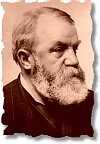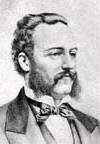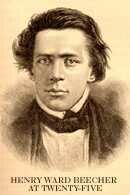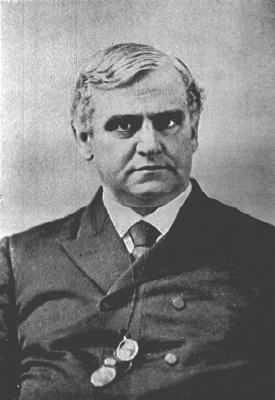|
Cities grew because of the industrial revolution. With urban growth came serious problems; problems that still defy solution. This page looks at the city's problems and then examines the life of the greatest revivalist of the late 1800s. I. BACKGROUND When winds of revival swept the country, no one completely ignored the cities but most of America's population was rural. By the 1830s, evangelist C.G. Finney began concentrating on city evangelism. He believed the nation's cultural life flowed from the cities t Two factors complicated evangelistic work in America's cities. First, many farm boys headed for the cities to find work. You see this movement from the farm to the city as early as the 1820s. When these young men reached the city several changes occurred. The city, with its many temptations and material opportunities, undercut their rural value system. Second, continuing immigration decreased work opportunities for native born Americans. Most of the immigrants settled in the cities. European immigrants also found themselves cut off from their previous value system. American cities grew rapidly. Chicago illustrates this best. Located in America's heartland, Chicago was a collection of seventeen houses in 1833. Eighty years later, Chicago had grown into the fifth largest city in the world and by 1900 it's population numbered 1,700,000. As the cities grew, the church faced the question of trying to ministry to a society involved in rapid growth. East coast Christians formed city missionary societies very early. Most of these societies reflect the impact of the "Benevolent Empire" in that they are pluralistic, voluntary and lay oriented. II. MEETING THE CITIES' PROBLEMS We identify "rescue missions" with city environments. However, most urban missionary societies did not organize like "rescue missions." "Seaman's Institutes" were set up first to reach sailors. Believers established these institutes on the east coast and along the Great Lakes. They provided housing, meals and religious instruction to sailors. The Salvation Army organized specifically to meet city needs. William Booth (1829-1912) orga Another organization which met the needs of the city was the Young Men's Christian Association (YMCA). Young men working in a large London mercantile business founded the first Y in 1844. George Williams, appalled at the lack of supervision for young men working in London stores and factories began Bible studies and religious services. Most large companies provided dormitory facilities for the many young men heading for the cities in those days. Factory and store owners quickly saw the value of the Y and help set them up in various locations. By 1847, the YMCA regularly offered Bible classes but it continued as a Christian hotel with religious services. The YMCA reached North America in 1851 when the organization established branches simultaneously in Montreal and Boston. Once established in the United States, the Y movement grew rapidly. By 1860, more than 205 YMCAs throughout the United States offered identical services to those in London. The YMCA expanded in 1858 when it established the first YMCA on a college campus at the University of Michigan. In time the Y's developed a fourfold program: spiritual, social, mental and physical. Early YMCAs were evangelistic. Many young men spent week ends and evenings in street evangelism distributing tracts and Bibles. Others served in city missions and preached from soap boxes on street corners. The YMCAs led in one of the most effective revival efforts of the late 1850s. Called "The Businessman's Revival," this revival grew out of a noon prayer meeting held at a New York YMCA. From New York, meetings spread to other cities around the country. All meetings followed the same format. Prayer meetings met from 12 noon to 1 p.m. Since businessmen led the meetings, they began and ended right on time. Men dropped in for as long as they could. Meetings were kept informal and unstructured except that leaders set up the service on five minute segments. Anyone could pray or preach as long as they kept to the five minute schedule. No activity succeeded itself. Observers could identify no visible leader. During the period of "The Businessman's Revival" American church membership increased 10%. Another YMCA outreach was the United States Christian Commission. The Y developed this organization during the Civil War as a YMCA for soldiers. The organization provided male nurses, workers who read letters from home, wrote letters and helped make contacts between families and commanding officers. Dwight L. Moody spend a couple of years with the USCC. III. REVIVALISM AND THE CITIES
Moody moved to Chicago where he hoped to find greater business opportunities. Rapidly growing Chicago was rapidly becoming the northwest's commercial center. Most retail stores in rural farming areas purchased their merchandise from Chicago wholesalers. Often these small businesses ran up accounts they couldn't pay. Moody then obtained the paper and tried to collect the debts. He persuaded Chicago merchants to accept discounted payments and Moody then persuaded the debtors to repay the bills at the discounted rate. He was so successful in this business that he saved $15,000 in a short time. While in Chicago, Moody became active in a Congregational Church. He rented a few extra pews then went out on the Chicago streets to fill them. At a nearby mission he taught boys and built an attendance of 1,500. This Chicago mission became the Illinois Street Church. In 1861 Moody gave up his business to become an independent inner city missionary. By the late 1860s, Moody felt more effort should be expended to reach the cities. While attending a Sunday School Convention in Indianapolis in 1870, Moody heard Ira Sankey sing. Moody walked up to Sankey and told him to meet him on a street corner near the convention hall at 6 p.m. Moody, who weighed about 300 pounds, was hard to disobey. Sankey showed up early. Moody arrived about one minute to six carrying a soap box. He picked Sankey up, put him on the box and said, "Sing." Sankey sang and a crowd gathered and Moody preached. Moody enjoyed little success during his early revivals. By 1870, however, he had become a full time evangelist. In 1872, Moody and Sankey went to England where his successes began. Four hundred responded to his first sermon. In 1873, they returned to the United States but again faced spotty successes. Only after a second trip to England did their American work take off. Moody established many of the contemporary revival methods. He began using massed choirs, ushers, advance preparation committees, and tickets for admission. The three "Rs" characterized his preaching: ruin by sin, redemption by Christ and regeneration by the Holy Spirit. In 1892, a heart ailment forced Moody into retirement. Chicago clergy invited Moody back to the city for the 1894 World's Fair. They had requested that the fair close down on Sundays but the fair committee refused. Moody's revival services drew such huge attendances that the fair forced down out of necessity. The 1800s also saw the development of the "Princes of the Protestant Pulpit." There were many individuals who fit this categorization, but I will name only two. The first is Henry Ward Beecher (1813-1887), a Congregational minister and 1837 graduate of Lane Theological Seminary. Beecher ministe
|
 o rural areas. While other revivalists held occasional meetings in cities, Finney focused on the urban masses.
o rural areas. While other revivalists held occasional meetings in cities, Finney focused on the urban masses. nized the East London Revival Society in England in 1878. This society later became the Salvation Army. The first American unit of the Salvation Army began in Philadelphia. In 1886, Ballington Booth, William Booth's son, arrived in the United States to direct the Army's work. By 1900, many chapters existed throughout the country. The elder Booth recalled Ballington to England in 1896, but he refused to return. William Booth charged his son with "mutiny" and dismissed him. Ballington Booth then formed the "Volunteers of America," an organization back
nized the East London Revival Society in England in 1878. This society later became the Salvation Army. The first American unit of the Salvation Army began in Philadelphia. In 1886, Ballington Booth, William Booth's son, arrived in the United States to direct the Army's work. By 1900, many chapters existed throughout the country. The elder Booth recalled Ballington to England in 1896, but he refused to return. William Booth charged his son with "mutiny" and dismissed him. Ballington Booth then formed the "Volunteers of America," an organization back  east much like Salvation Army. Some say the Volunteers work with a higher class citizen than Salvation Army. Both organizations reflect their founders' Wesleyan heritage and emphasize perfectionism.
east much like Salvation Army. Some say the Volunteers work with a higher class citizen than Salvation Army. Both organizations reflect their founders' Wesleyan heritage and emphasize perfectionism. (1837-1899) was the greatest urban evangelist of the 1800s. Born just outside Northfield, Massachusetts on a farm, Moody went to Boston in 1854 at the age of 17 to seek his fortune. He first worked as a clerk in his uncle's Boston shoe store. Upon his arrival in the city Moody faced the same temptations any rural youth faced in the big city. Moody had a Congregational background but he wasn't a church member. One day Moody's Sunday School teacher dropped in to see him at the store and led him to a decision. Moody's decision followed a warm, calm, unfrenzied presentation of the Gospel. Moody used a similar approach during his subsequent evangelistic efforts.
(1837-1899) was the greatest urban evangelist of the 1800s. Born just outside Northfield, Massachusetts on a farm, Moody went to Boston in 1854 at the age of 17 to seek his fortune. He first worked as a clerk in his uncle's Boston shoe store. Upon his arrival in the city Moody faced the same temptations any rural youth faced in the big city. Moody had a Congregational background but he wasn't a church member. One day Moody's Sunday School teacher dropped in to see him at the store and led him to a decision. Moody's decision followed a warm, calm, unfrenzied presentation of the Gospel. Moody used a similar approach during his subsequent evangelistic efforts.

 red to the Plymouth Congregational Church in Brooklyn. He advocated social reform in New York. He also preached in favor of theistic evolution and biblical criticism. A charge of adultery damaged his ministry. He probably had an affair with his church secretary or an organist. The second is Phillips Brooks (1835-1893), a Episcopalian known for his ministry with Boston's Trinity Church. Brooks went to Boston in 1867 and served most of his career there. He was a "broad church" Episcopalian meaning that he fellowshipped inclusively. Brooks and Beecher both represent a liberal wing of Protestantism during the period. The located preachers tended towards liberalism while the itinerant evangelists, like Moody, remained conservative.
red to the Plymouth Congregational Church in Brooklyn. He advocated social reform in New York. He also preached in favor of theistic evolution and biblical criticism. A charge of adultery damaged his ministry. He probably had an affair with his church secretary or an organist. The second is Phillips Brooks (1835-1893), a Episcopalian known for his ministry with Boston's Trinity Church. Brooks went to Boston in 1867 and served most of his career there. He was a "broad church" Episcopalian meaning that he fellowshipped inclusively. Brooks and Beecher both represent a liberal wing of Protestantism during the period. The located preachers tended towards liberalism while the itinerant evangelists, like Moody, remained conservative.